(2) Option 2. The company FSO works out of the FSV, which he positions where he can most effectively observe and control execution of the fire support plan. The FSO
establishes OPs that take maximum advantage of the capability of the Striker to create lethal, accurate fires. He communicates with the commander on the company command net. This option allows the FSO to maintain effective control of any designated observers and to conduct required fires and effects coordination. He must keep the company informed at all times of his location and the routes he will take when moving from OP to OP.
10-17. MORTARS
The mortar section is made up of two squads, each consisting of two 60-mm mortars or two 120-mm mortars and crew (Figures 10-6 and 10-7). The mortar section leader must work closely with the company commander and his FSO to maximize the section's fires.
10-23
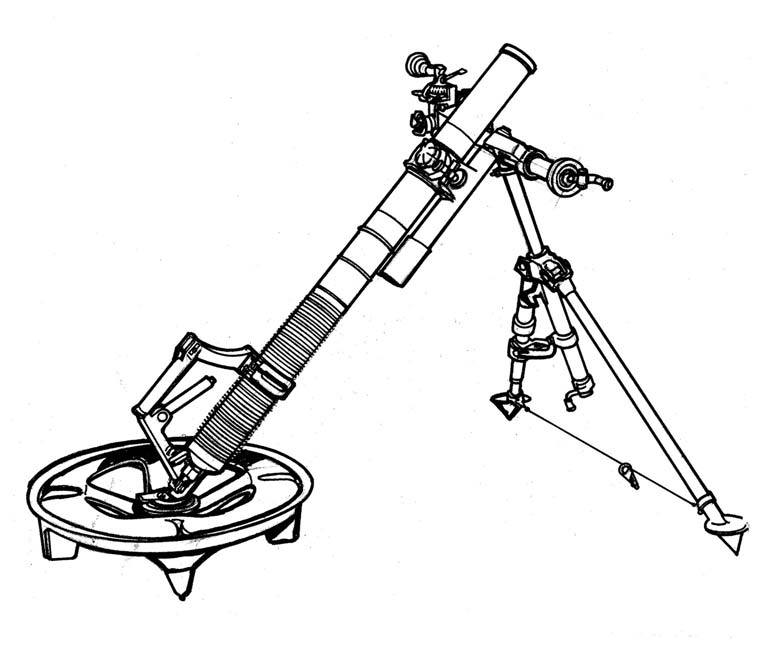
FM 3-21.11
The platoon has two vehicles to move its equipment, ammunition, and personnel; it also has an organic FDC. Table 10-6, page 10-26, shows the different ranges and types of ammunition for the company mortar systems. Teamwork is the key to an efficient mortar section. Duties must be constantly drilled and personnel cross-trained.
Figure 10-6. 60-mm mortar dismounted.
10-24
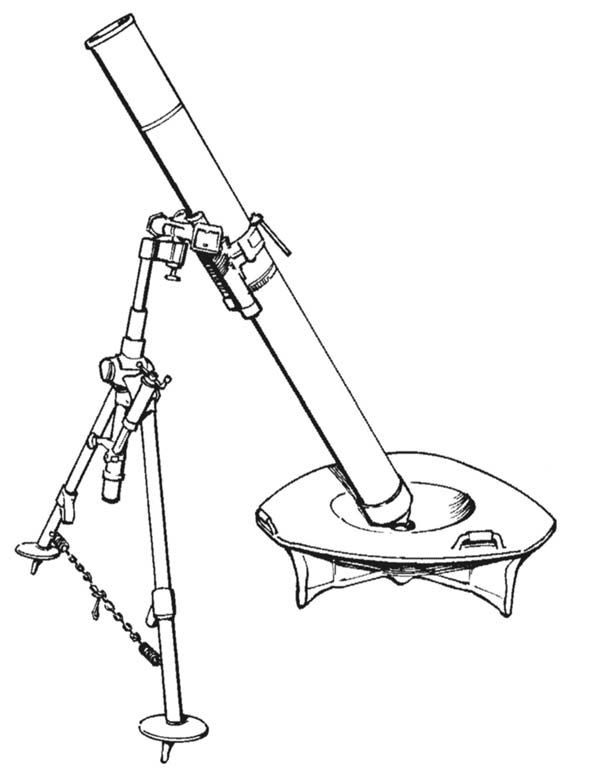
FM 3-21.11
Figure 10-7. 120-mm mortar (dismounted).
10-25
FM 3-21.11
SIZE/
MIN
MAX
DIAMETER
NOMEN
MODEL TYPE
RANGE RANGE
OF ILLUM
ROF
60-mm
M720/M998
HE
70
3500(1)
30 RDS PER
M224
M722
WP
70
3500
MINUTE FOR 4
MINUTES(2) THEN
M721
ILLUM
200
3500
500
20 RDS PER
M302A1
WP
35
1830
MINUTE
M83A3
ILLUM
725
950
300
SUSTAINED
M494A
HE
45
1830
120-mm
M57
HE
200
7200
15 RDS PER
M121
M68
WP
200
7200
MINUTE FOR 1
MINUTE, THEN 4
M91
ILLUM
200
7100
1500
RDS PER MINUTE
M933
HE (PD)
200
7200
SUSTAINED
M934
HE (MOF)
200
7200
M929
WP
200
7200
M930
ILLUM
200
7200
1500
(1) BIPOD MOUNTED, CHARGE 4 (MAXIMUM RANGE HANDHELD IS 1300 METERS).
(2) CHARGE 2 AND OVER. 30 RDS PER MINUTE CAN BE SUSTAINED WITH CHARGE 0 OR 1.
Table 10-6. Mortar ammunition characteristics.
a. Mortar Section Leader. The mortar section leader is responsible (overall) to the company commander for the mortar section. His duties include--
• Advising the commander on employing and positioning the mortar section.
• Assisting the FIST chief in planning fire support for the company.
• Keeping the commander informed of the location of the mortar section and the status of the mortars and ammunition.
• Maintaining a situation map showing all supported units' locations, mortar positions, maximum range lines, and targets.
• Planning, initiating, and supervising the timely displacement of the section.
• Supervising security, resupply, and communications for the section.
• Seeing that preparations are made for special firing techniques, such as direct lay and direct alignment.
• Performing the duties of chief computer.
• Cross-checking target plots.
• Maintaining ammunition records and submitting resupply requests.
• Recommending to the commander when the mortars should displace and controlling their displacement.
• Relaying enemy information from designated observers to the company and others, as directed.
b. Mortar Squad Leader. The mortar squad leader and gunners' responsibilities include--
• Moving and positioning the mortar as directed.
• Ensuring that the mortar is properly laid.
• Checking camouflage and overhead and mask clearance.
10-26
FM 3-21.11
• Maintaining a map showing positions, sectors, and targets (needed for independent operations or when displacing by squads).
• Computing firing data for independent operations.
• Ensuring that ammunition is properly stored.
• Checking rounds for indexing and charges.
• Maintaining communications with the FDC, when applicable.
10-18. MORTAR POSITIONS
Based on the mission, terrain, and SBCT infantry rifle company commander’s guidance, the mortar section leader reconnoiters and selects mortar firing positions. In the battalion mortar platoon, a representative from the base gun and one man from the FDC may help reconnoiter and prepare the new position.
a. A mortar
section position should--
• Allow firing on targets throughout the company’s sector or zone, or the supported platoon’s sector or zone. In the offense, one half to two thirds of the range of the mortars should be forward of the lead platoon. This reduces the number of moves needed.
• Be in defilade to protect the mortars from enemy observation and direct fire.
Places such as the reverse slope of a hill, a deep ditch, the rear of a building, and the rear of a stonewall are well suited for mortar positions. The reverse slope of a hill may protect mortars from some indirect fire.
• Have concealment from air and ground observation. Vegetation is best for breaking up silhouettes. Vehicles should be positioned in defilade where natural camouflage conceals them. When the location of the firing position provides little concealment, consider the use of a hide position, which provides good cover and concealment and allows the mortar crews to quickly occupy their firing positions when required.
• Have overhead and mask clearance. Overhead clearance is checked by setting the sight at maximum elevation and looking along the mortar tube. Mask clearance is checked the same way, but at minimum elevation.
• Have solid ground that supports vehicle movement and precludes excessive settling of base plates. On soft ground, put sandbags under base plates to reduce settling.
• Have 25 to 30 meters between 60-mm mortars and 35 to 40 meters between 120-mm mortars. This reduces the chances of having more than one mortar hit by one enemy round. It also provides proper sheaf dispersion without plotting for each gun.
• Have routes in and out. These routes should ease resupply and displacement.
• Be secure. The section may have to provide its own local security. Being near other friendly units improves security.
• Avoid overhead fire of friendly soldiers when possible.
b. The FDC may be in voice-distance of the squads; however, telephone wire should be laid from the FDC to each squad for security purposes and because battle noise may be so intense that the squads cannot hear the commands.
c. The mortar section has a very limited capability to secure itself. Normally, it collocates with other elements or has a security element attached.
10-27
FM 3-21.11
d. Mortar crews prepare mortar positions to protect themselves and to serve as firing positions for the mortars. The crews construct the positions with sandbags, ammunition boxes, earth, or any other available materials. (FM 7-90 describes these dug-in positions.) 10-19. MORTAR EMPLOYMENT
In a movement to contact, the mortar section usually supports the SBCT infantry company with priority of fire to the lead platoon. The section normally displaces one squad at a time so that at least one squad is always in position and ready to fire. The section's displacement is based on the company’s movement. The leader keeps the company commander informed of the location and status of his weapons and ammunition. The observers report their locations to the FDC.
a. In an attack, sections prepare initial firing positions and may stockpile ammunition. They occupy positions at the last moment before the attack. The section must remain ready throughout the attack to respond to calls for fire and to displace, if necessary.
b. In the defense, mortars are farther to the rear than in the offense. The company commander plans his mortar section's final protective fire on a dangerous, dismounted enemy avenue of approach. Extra ammunition is stockpiled (if feasible). The mortars have some security when behind forward troops, but they still prepare to defend their positions.
c. To avoid being suppressed, a number of mortar positions are designated, prepared (if feasible), and occupied as required during the battle.
d. In a withdrawal not under enemy pressure, one or more mortars may be left in position to support the DLIC.
e. No matter where the platoon or section is located, it does everything it can for its own security. It may be able to post one or two security elements (equipped with Claymore mines and AT4s) on the most dangerous approaches. It also uses early warning devices. If attacked, the security elements give warning, kill as many of the enemy as they can, and then rejoin their squads. The rest of the unit defends them from the dug-in mortar positions. The company reserve may be employed for a counterattack or to improve the security and defense of the mortar section.
f. The mortar section leader coordinates the section defense plan with the company reserve. Targets are planned around the section's position so other mortars or artillery can provide support.
10-20. MORTAR DISPLACEMENT
Mortars displace to provide continuous support and to evade suppression, whether the company is attacking or defending. This paragraph applies to both 60-mm and 120-mm mortars when man-packed by the platoon or section. (When displacing the 120-mm platoon with vehicles, refer to Chapter 3 of this manual and FM 7-90.) a. The displacement plan and the position of the mortar section in the company formation should not disrupt the maneuver elements, should be responsive to the commander, and should provide the mortar section with local security. It should also allow the mortars to go into action quickly using the desired method of engagement and should provide ammunition resupply for the mortars. The displacement plan flows 10-28
FM 3-21.11
logically from other decisions made by the company commander, the company FSO, and the mortar section leader.
b. If the company commander determines that operations (offensive or defensive) will move slowly enough to stay within mortar range and that continuous indirect fires must be available, he may order the mortars to displace to a suitable support position before the company moves out. In this event, he may not move them again until the company reaches its next position. The choices available for displacement are displacement by section and displacement by squad:
(1) Displacement by Section. The whole section displaces at the same time. This allows the section to mass fires and the section sergeant to keep good control of his section. Moving as a platoon or section maximizes the limited FDC capability. It also is the fastest method of displacement. While the section is moving, its fire support is not immediately available unless it is positioned to fire using the direct lay or direct alignment methods or by conducting a hip shoot. Using any of these methods, the mortar section can be available with only minimum delay.
(2) Displacement by Squad. This method allows continuous coverage of at least part of the company's sector. Because there is only one radio in the mortar section and six men for the 60-mm, it is difficult to provide continuous indirect fire coverage even when displacing by squad. It is possible, however, for the company to attach one squad to each of two bounding platoons so that while using the direct lay or direct alignment methods, one squad is always in overwatch of the company's movement. This may allow increased mortar coverage of the company sector during decentralized operations. It reduces the difficulty of transporting the mortar ammunition and also may be the most effective means of infiltrating the mortars. Each section carries the ammunition for the attached gun squad.
c. The company commander also decides whether to move the mortars as a separate element in the company formation or to attach each gun squad to a subordinate element.
(1) Attached. The mortars are attached to a subordinate element when the situation requires that task organization (on a patrol or with the company support element, for example) or when the mortars need additional control, security, and load-carrying capacity (during an infiltration, for example).
(2) Separate. The mortars move as a separate element in the company formation when the commander wishes to control them directly and keep them together for massed use. When the mortars move as an element, they can displace by section or by squad.
10-21. MORTAR ENGAGEMENTS
There are various engagement methods: direct lay and direct alignment (which do not require a fire direction center), the conventional indirect fire, and the hip shoot. The primary methods of engagement for the 60-mm mortar are direct lay and direct alignment.
a. Direct Lay. This method is used when the gunner can see the target. The mortar may be handheld or bipod-mounted. An initial fire command is required to designate the target and (if desired) specify the shell-fuze combination and number of rounds. The gunner then adjusts fire and fires for effect without additional instructions (Table 10-7, page 10-30).
10-29
FM 3-21.11
ADVANTAGES OF DIRECT LAY
DISADVANTAGES OF DIRECT LAY
• Can engage target immediately in
• Requires the mortar crew to be relatively
handheld mode (the mortar weighs only 18
close to the enemy and therefore
pounds and is therefore highly portable).
susceptible to direct and indirect fires.
• Can be used by relatively untrained
• Is less effective at night (the gunner cannot
gunners, such as cross-trained
engage when he cannot see).
infantrymen.
• Does not require an FDC.
Table 10-7. Advantages and disadvantages of direct lay.
b. Direct Alignment. This method allows the mortar crew to fire from full defilade positions without an FDC. It requires that an observer be within 100 meters of the gun-target line and, if possible, within 100 meters of the guns. Direct alignment can be used only when handheld or bipod-mounted, although bipod-mounted is much more accurate (Table 10-8).
ADVANTAGES OF DIRECT ALIGNMENT
DISADVANTAGES OF DIRECT ALIGNMENT
• Can engage target more quickly than the
• Is slightly slower than direct lay.
methods requiring an FDC.
• Requires the mortar crew to be relatively
• Allows crew more protection than direct
close to the enemy and therefore
lay.
vulnerable to indirect fires or assault.
• Does not require an FDC.
• Requires a well-trained observer to be
within 100 meters of the gun-target line
(preferably within 100 meters of the guns).
• Requires observers to be in direct
communication with the gun crew by voice,
arm-and-hand signal, landline, or radio.
• Requires gun to be re-laid to engage each
different target.
Table 10-8. Advantages and disadvantages of direct alignment.
c. Conventional Indirect Fire. This method is used when the mortars have been laid for direction and an FDC established with positions plotted on the M16 plotting board or the mortar ballistic computer (MBC). In this situation (for the 60-mm mortar), the section leader operates the MBC or the M16 plotting board and the radio as the FDC
(Table 10-9).
10-30
FM 3-21.11
ADVANTAGES OF
DISADVANTAGES OF
CONVENTIONAL INDIRECT FIRE
CONVENTIONAL INDIRECT FIRE
• Can fire accurately at any target within
• Requires an FDC (there is no designated
range as long as an observer who can
FDC in the light infantry mortar section).
communicate with the FDC observes the
• Is not as responsive as direct lay.
target.
• Can accurately engage plotted targets
during limited visibility.
• Can locate well away from enemy direct
fires.
Table 10-9. Advantages and disadvantages of conventional indirect fire.
d. Hip Shoot. When a call for fire is received during movement and the target cannot be engaged by either the direct lay or direct alignment method, a hip shoot is initiated. A hip shoot is a hasty occupation of a firing position; it requires both an FDC
and an observer. The section leader normally acts as the FDC (60-mm only). The observer’s corrections may be sent over the radio or by a wire net. The platoon or section leader must quickly determine an azimuth of fire by map inspection. He then gives this direction to the mortar squads. The second squad leader uses the M2 compass (for the 60-mm section) to lay the base mortar. The section leader uses the MBC, the graphical firing scale, or the firing tables to determine the appropriate elevation and charge. He uses either the MBC or the M19 plotting board to refine the firing data based on the observer's corrections. The section leader may use the aiming-point deflection method, depending upon the terrain. The second mortar is laid either by sight-to-sight or M2 compass (Table 10-10).
ADVANTAGES OF HIP SHOOT
DISADVANTAGES OF HIP SHOOT
• Allows fire support when other methods of
• Requires an FDC (there is no designated
engagement are not usable.
FDC in the light infantry mortar section).
• Is able to move at the same time as the
• Is the slowest method of fire and the least
unit and still provide adequate fires.
accurate.
Table 10-10. Advantages and disadvantages of hip shoot.
Section III. ENGINEERS
The two core qualities of the SBCT infantry company are high mobility and the ability to achieve decisive action through dismounted infantry assault. At the tactical level, overmatching mobility is critical to the success of the force. Given the significance of tactical mobility to the SBCT's successful operations, the SBCT engineers are essential.
10-22. ORGANIZATION AND CAPABILITIES
SBCT engineer structure provides the SBCT commander with the embedded engineer integration required to train, rehearse, plan, and execute synchronized mobility operations. This structure includes--
10-31
FM 3-21.11
• A four-man staff engineer planning section within the maneuver support cell.
• An organic medium engineer company outfitted with a full complement of engineer equipment adapted to or mounted on the SBCT’s common vehicular platform.
10-23. ENGINEER COMPANY, BRIGADE COMBAT TEAM
The SBCT’s organic engineer company provides embedded, responsive mounted and dismounted maneuver support. The engineer company supports the maneuver force--the SBCT infantry battalions and companies. It readily integrates into maneuver operations and organizations at all levels based on the analysis of tasks required. It is an agile organization that assures freedom to maneuver on the battlefield within the combined-arms-team framework. The engineer company has three combat mobility platoons, one mobility support platoon, and a company headquarters section (Figure 10-8). The engineer company is the lowest engineer echelon organic to the SBCT that can plan and execute continuous 24-hour operations in support of SBCT operations. The engineer company normally task-organizes its platoons to infantry battalions and companies in a specific command-support relationship to provide a mission-specific, tailored package. It performs mounted and dismounted engineer tasks equally well.
10-32
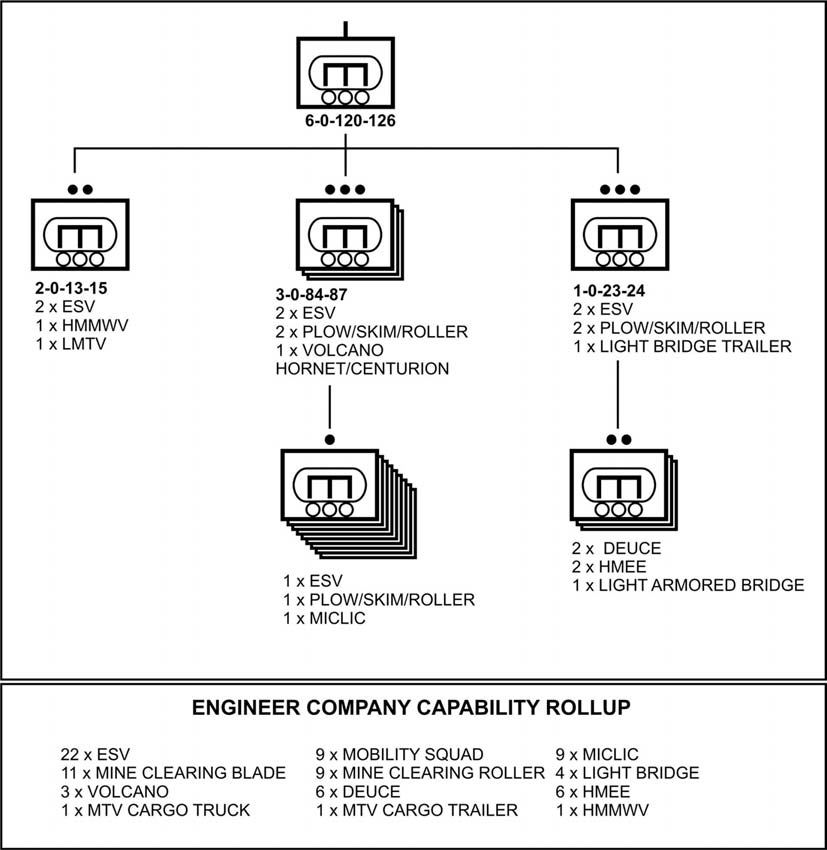
FM 3-21.11
Figure 10-8. SBCT engineer company organization and equipment.
a. Combat Mobility Platoon. The combat mobility platoon is normally the lowest-level engineer unit that can effectively accomplish independent mounted engineer missions and tasks. It is the basic building block of engineer force allocation and task organization. A combat mobility platoon normally is task-organized to support an infantry battalion, but it may support an infantry company based on METT-TC analysis.
The combat mobility platoon may receive augmentation in the form of special equipment from the mobility support platoon. Engineer platoon-specific common-platform equipment includes engineer support vehicles (ESVs) with mountable rollers or blades, light assault bridges, light earthmovers (deployable universal combat earthmovers
[DEUCEs]), excavators (HMEEs), MICLICs, and multiple-delivery mine systems (Volcanoes) (Figure 10-9, page 10-34). The combat mobility platoon’s eight-man engineer squads carry a variety of explosives and demolitions. The squad is normally the minimum force required to provide effective dismounted support to infantry companies.
The squad is the engineer organization most likely to support an infantry company, particularly during offensive operations.
10-33
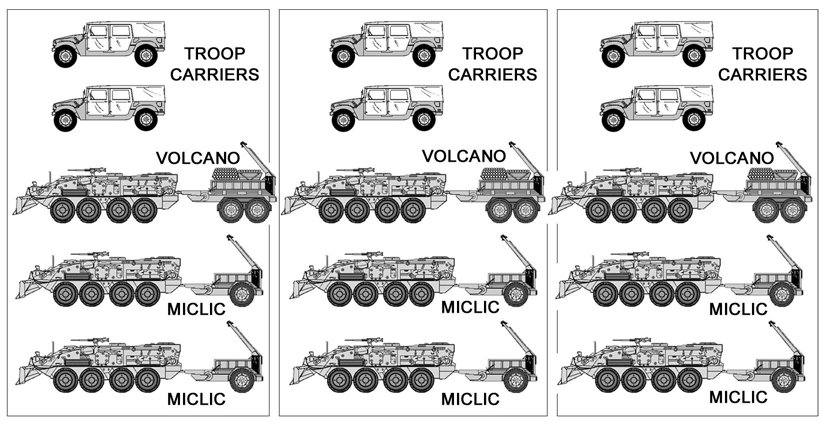
FM 3-21.11
Figure 10-9. Combat mobility platoon.
b. Mobility Support Platoon. The mobility support platoon consists of a platoon headquarters section and three equipment-based mobility sections (Figure 10-10). Unlike the combat mobility platoon, it is not organized to operate independently during offensive operations. The mobility support platoon provides the commander with specialized equipment capabilities to weight the main effort and to perform specialized mobility tasks. Each section is structured to provide equipment augmentation, focused on reducing enemy obstacles and fortifications, to each of the three combat mobility platoons. Each section has gap-crossing, obstacle-reduction, special-tool, and heavy-blade capabilities.
The mobility support platoon provides a limited capability for countermobility, survivability, and sustainment operations.
10-34
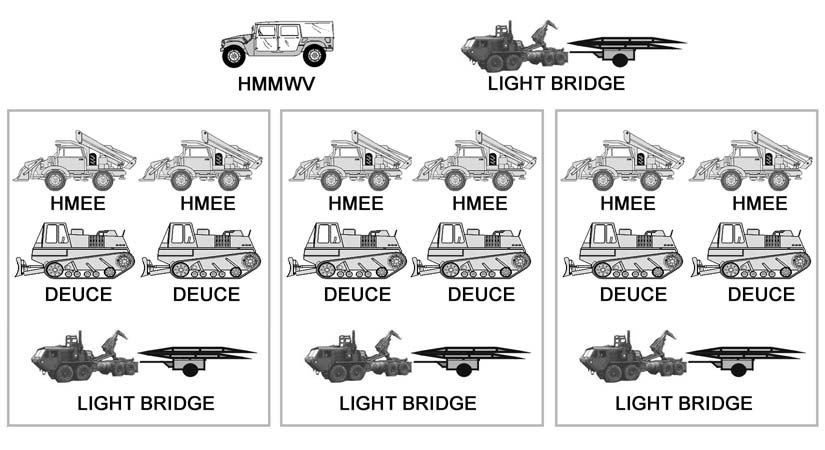
FM 3-21.11
Figure 10-10. Mobility Support Platoon.
10-24. MOBILITY
At the tactical level, overmatching mobility is critical to the success of the force. Within this context, the emphasis of engineer integration across the force is on mobility operations. Due to the full-spectrum capability of the infantry company and the increasingly nonlinear, asymmetric nature of the threat, the potential exists for the company to encounter a wide variety of existing and reinforcing obstacles. To counter this pot








